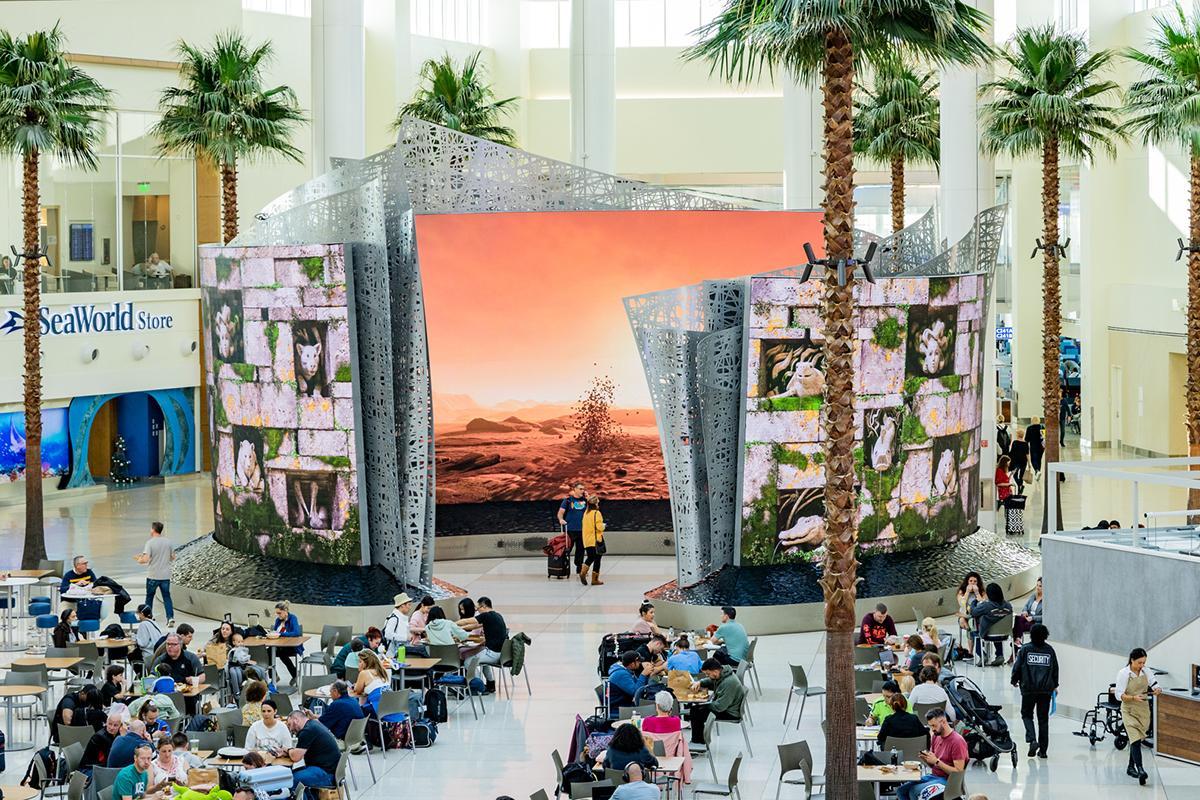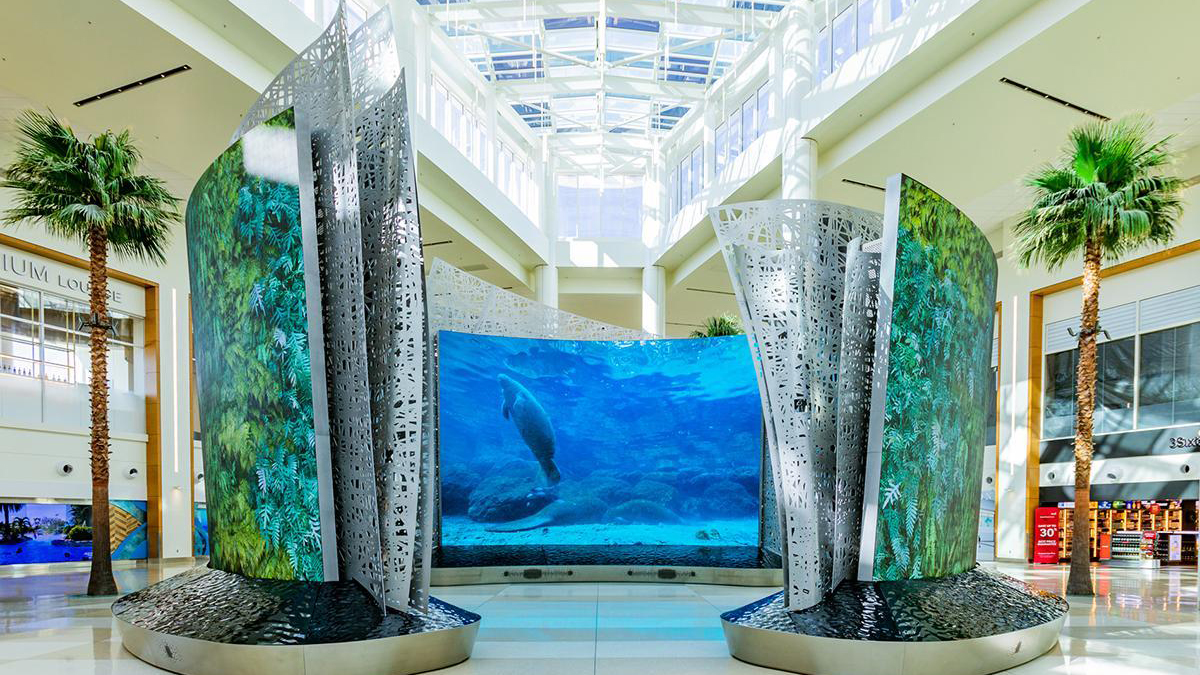Orlando International Airport (MCO) recently unveiled the new South Terminal Complex, which welcomes travelers with an Experiential Media Environment (EME) in the Airside Hub. The EME was conceptualized by executive producer MRA International Group, with executive creative director Marcela Sardi of Sardi Design, and features a series of large-scale multimedia content by Gentilhomme Studio.
A focal point of the EME is the Moment Vault, a compelling immersive multimedia installation powered by the latest interactive technologies. Passengers can walk through three large curved 2mm LED displays (positioned in a circle) and become part of the onscreen presentation.
[Why dvLED Is Gaining Market Share]
The exterior of the Moment Vault is also adorned with 4mm dvLED displays, ensuring that every visitor in Terminal C can be part of the experience, even if they don’t walk through the middle of the installation. The Moment Vault is the first part of Terminal C’s EME, which will grow to include two additional high-tech installations.
Smart Monkeys, a Florida-based consulting firm that specializes in feature-centric technology implementations for location-based entertainment, designed and managed the Moment Vault technology. The installation uses Realmotion’s interactive media servers and an AI-powered, marker-less motion capture system. The total solution provides content creators a unique set of capabilities that enable novel, "selfie-ready" interactive experiences for travelers, according to Alexandre Simionescu, Realmotion founder and project lead.
Realmotion, which had previously worked with Smart Monkeys, was brought in to provide a media server with generative content capabilities and the motion capture system. The company’s powerful new multi-GPU Fusion server uses six cameras to provide 3D marker-less tracking for up to 25 subjects within the confines of the Moment Vault. Each subject's motion is instantly converted into digital wireframes. The real-time tracking system then transmits the data to three Realmotion G32 servers, which feed the data into an Unreal Engine scene.
The setup involves AI and machine learning to ensure accurate people tracking through the generation of a "3D pose estimate" for every individual in the space. Each pose estimate is used to accurately place real-time virtual avatars in live digital content.

Previous pose estimate solutions only worked in 2D and could not differentiate between the size and distance of objects, so Realmotion designed its new, proprietary system, which provides precise, responsive, and robust 3D marker-less tracking for groups of users. Plus, multiple camera angles also eliminate occlusion, or sight-line blockages, which would otherwise miss visitors who are behind someone else relative to the camera.
“This project is a crowd pleaser, and that is its intent,” Simionescu continued. “More and more organizations are looking to create novel technological experiences for customers and guests, and they often require significant research and development, including software design and new combinations of hardware. At Realmotion, we are building on the success of our tools by turning the best of them into productized solutions that can be deployed industry-wide with greater speed and affordability, as we are planning to do with our G32 and Fusion servers that helped bring the Moment Vault to life.”
[Why Go Wide with dvLED Displays?]
“Creating installations that support generative content is critical to maximizing use and flexibility and provides today’s artists with the tools and canvasses they need to present their latest works,” said Paul Bristol, design consultant, Smart Monkeys. “Often, art installations are temporary traveling exhibits that require tight scheduling and limited options for the host location. With the amazing, permanent digital canvas offer in the Moment Vault, Orlando International Airport can offer much greater visibility and opportunity to artists and content creators, while enjoying a simpler, more powerful management system.”
The EME project was a collaborative effort among the Greater Orlando Aviation Authority, Gentilhomme Studio, Sardi Design, Burns Engineering, MRA International Group, Hahn International, SACO, Smart Monkeys, Realmotion, Electrosonic, and others. A core goal of the project was to ensure operating and updating the displays is as easy as possible for both owners and artists.
Realmotion’s advanced products and capabilities made it an ideal choice for this project—and its servers are fully compatible with the ISAAC AV monitoring and management platform used by Smart Monkeys. To help prepare content developers, Realmotion built a software emulator of the tracking system that allows creators to test and develop reactive content without requiring real-world subjects or displays.
“We’re also working directly with artists to help identify more streamlined workflows and cut down the time required to go from concept to presentation,” Bristol added. “Our innovations, combined with improvements in LED technology and the supporting infrastructure that enable drag-and-drop content control, can drastically cut the time-to-market for art pieces, reduce costs for owners, and enable more artists to be featured."
“There is high demand for creating memorable moments that don’t require physical touch or employee interaction, and their use is certain to grow as travelers and consumers begin to expect these types of installations,” Simionescu said. “Where there’s a will, there’s a way, and now that we’ve figured out the way to deliver these amazing experiences, we are excited to see what other organizations have the desire to build something special with us."
